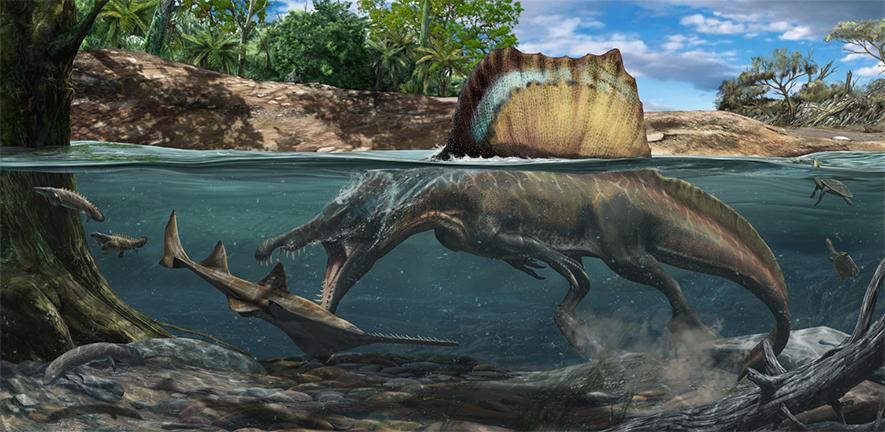
Its close cousin Baryonyx probably swam too, but Suchomimus might have waded like a heron.
Its close cousin Baryonyx probably swam too, but Suchomimus might have waded like a heron.
There’s nothing like Spinosaurus in our modern world, but they had a number of traits that we see today in semi-aquatic animals who specialise in aquatic prey
Guillermo Navalón
Spinosaurus is the biggest carnivorous dinosaur ever discovered—even bigger than T. rex—but the way it hunted has been a subject of debate for decades. Based on its skeleton, some scientists have proposed that Spinosaurus could swim, but others believe that it waded in the water like a heron.
To help solve this mystery, palaeontologists from the Universities of Cambridge and Oxford, and the Field Museum in Chicago, USA, have taken a different approach by examining the density of their bones and comparing them to animals like penguins, hippos and alligators.
The team’s analysis, published in the journal Nature, found that Spinosaurus and its close relative Baryonyx had dense bones that likely would have allowed them to submerge themselves underwater to hunt. Meanwhile, another related dinosaur called Suchomimus had lighter bones that would have made swimming more difficult, so it likely waded instead or spent more time on land like other dinosaurs.
“The fossil record is tricky — there are only a handful of partial spinosaurid skeletons, and we don’t have any complete skeletons for these dinosaurs,” said co-lead author Dr Matteo Fabbri from the Field Museum. “Other studies have focused on interpretation of anatomy, but if there are such opposite interpretations regarding the same bones, this is already a clear signal that maybe those are not the best proxies for us to infer the ecology of extinct animals.”
“There’s nothing like Spinosaurus in our modern world, but they had a number of traits that we see today in semi-aquatic animals who specialise in aquatic prey,” said co-lead author Dr Guillermo Navalón from Cambridge’s Department of Earth Sciences.
All life initially came from water, and most groups of terrestrial vertebrates contain members that have returned to it—for instance, while most mammals are land-dwellers, we’ve got whales and seals that live in the ocean, and other mammals like otters, tapirs, and hippos that are semi-aquatic. For a long time, non-avian dinosaurs (those that didn’t branch off into birds) were the only group without any water-dwellers. That changed in 2014, when a new Spinosaurus skeleton was described.
Scientists already knew that spinosaurids spent some time by water—their long, crocodile-like jaws and cone-shaped teeth are like those of other aquatic predators, and some fossils had been found with bellies full of fish. But the Spinosaurus specimen described in 2014 had retracted nostrils, short hind legs, paddle-like feet, and a fin-like tail: all signs that pointed to an aquatic lifestyle. But researchers have continued to debate whether spinosaurids swam for their food or if they just stood in the shallows and dipped their heads in to snap up prey.
This continued back-and-forth led the researchers to try to find another way to solve the problem.
“Instead of trying to know as much as possible about the whole skeleton of Spinosaurus, we asked a much simpler question — what are the most important small-scale observations that would tell you whether animals routinely swim or not?” said co-lead author Professor Roger Benson from the University of Oxford.
Across the animal kingdom, bone density is a tell in terms of whether that animal can sink beneath the surface and swim. Dense bone works as buoyancy control and allows the animal to submerge itself.
“We thought maybe this is the proxy we can use to determine if spinosaurids were actually aquatic,” says Fabbri.
The researchers put together a dataset of femur and rib bone cross-sections from 250 species of extinct and living animals, from seals, whales, elephants, mice and hummingbirds, to dinosaurs of different sizes, to extinct marine reptiles like mosasaurs and plesiosaurs.
They compared these cross-sections to bone from Spinosaurus and its relatives Baryonyx and Suchomimus. “We had to divide this study into successive steps,” said Navalón. “The first was to understand if there is actually a universal correlation between bone density and ecology. And the second was to infer ecological adaptations in extinct taxa.”
Essentially, the team had to show a proof of concept among present-day animals that we know for sure are aquatic or not, and then apply it to extinct animals that we can’t observe.
The study revealed a clear link between bone density and aquatic foraging behaviour: animals that submerge themselves underwater to find food have bones that are almost completely solid throughout, whereas cross-sections of land-dwellers’ bones look more like doughnuts, with hollow centres.
“Aquatic animals need to be able to control their buoyancy, but terrestrial animals don't have this problem,” said Navalón. “Because bones are mineralised tissue, controlling the rate of deposition of mineralised tissue within them is the easiest route to become denser or lighter for a land-dwelling vertebrate. This happened in many groups that underwent the ‘back to water’ evolutionary journey: from whales and hippopotamuses to penguins and marine reptiles that lived in the distant past.”
When the researchers applied spinosaurid dinosaur bones to this paradigm, they found that Spinosaurus and Baryonyx both had the sort of dense bone associated with full submersion.
“If we combine all these pieces of evidence, Spinosaurus might have moved through shallow water using a combination of ‘bottom-walking’ – like modern hippos – and side-to-side strokes of its giant tail,” said Navalón. “It probably used this means of locomotion not to pursue prey for long distances in open water, but to ambush and catch very large fish like lungfishes or coelacanths that lived in the same environment.”
Meanwhile, the closely-related Suchomimus had hollower bones. It still lived by water and ate fish, as evidenced by its crocodile-mimic snout and conical teeth, but based on its bone density, it wasn’t actually swimming.
Other dinosaurs, like the giant long-necked sauropods also had dense bones, but the researchers don’t think that meant they were swimming. “Very heavy animals like elephants and rhinos, and like the sauropod dinosaurs, have very dense limb bones, because there’s so much stress on the limbs,” said Fabbri. “The other bones are pretty lightweight. That’s why it was important for us to look at a variety of bones from each of the animals in the study.” And while there are limitations to this kind of analysis, there is potential for this study to tell us about how dinosaurs lived.
“One of the big surprises from this study was how rare underwater foraging was for dinosaurs, and that even among spinosaurids, their behaviour was much more diverse that we’d thought,” said Navalón.
The study shows how much information can be gleaned from incomplete specimens. “The good news with this study is that now we can move on from the paradigm where you need to know as much as you can about the anatomy of a dinosaur to know about its ecology, because we show that there are other reliable proxies that you can use,” said Fabbri.
Reference:
Matteo Fabbri, Guillermo Navalón, Roger B J Benson et al. ‘Subaqueous foraging among carnivorous dinosaurs.’ Nature (2022). DOI: 10.1038/s41586-022-04528-0
Adapted from a Field Museum press release.

The text in this work is licensed under a Creative Commons Attribution 4.0 International License. Images, including our videos, are Copyright ©University of Cambridge and licensors/contributors as identified. All rights reserved. We make our image and video content available in a number of ways – as here, on our main website under its Terms and conditions, and on a range of channels including social media that permit your use and sharing of our content under their respective Terms.




